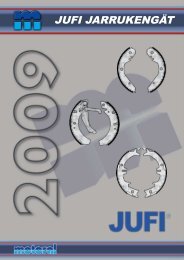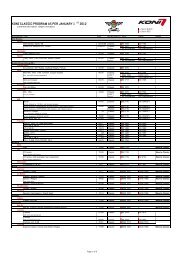- Page 1 and 2: GB 2011-2012
- Page 3 and 4: GB The spark plugs, glow plugs, and
- Page 5 and 6: Tightening torques for spark plugs
- Page 7 and 8: Symbols used on spark plugs The sta
- Page 9 and 10: Symbols used on metal glow plugs Sh
- Page 11 and 12: V-Line - a sales concept with many
- Page 13 and 14: V-Line V-Line No. 25 NGK has develo
- Page 15 and 16: V-Line overview V-Line Type Automob
- Page 17 and 18: LPG LaserLine - the best for gas op
- Page 19: LPG LaserLine - Optimum market cove
- Page 23 and 24: 2011-2012 NGK racing spark plugs GB
- Page 25 and 26: GB 23
- Page 38 and 39: 78 91 18 Y-102 M10x1.25 12 Hex 10,5
- Page 40 and 41: 96 105,5 32,0 Y-118 R M10x1.25 12 H
- Page 42 and 43: 101 Y-197 T M10x1.25 12 Hex 23 V 62
- Page 44 and 45: 80 108 24,0 Y-405 M14x1.25 17 Hex 9
- Page 46 and 47: 170 36 Y-531 J M10x1.25 12 Hex 11 V
- Page 48 and 49: 90 73 24,5 Y-710 J M10x1.25 12 Hex
- Page 50 and 51: 129 88 30,0 Y-746 J M10x1.0 10 Hex
- Page 52 and 53: 60 115 20,0 Y-918 J M12x1.25 12 Hex
- Page 54 and 55: 150 69 26,5 Y-8002 AS M8x1.0 8Hex 4
- Page 56 and 57: 89 84 22,0 CX 51 M10x1.25 10 Hex 6,
- Page 59 and 60: kW Cyl. Order- LPG/CNG Order- No. N
- Page 61 and 62: kW Cyl. Order- LPG/CNG Order- No. N
- Page 63 and 64: kW Cyl. Order- LPG/CNG Order- No. N
- Page 65 and 66: kW Cyl. Order- LPG/CNG Order- No. N
- Page 67 and 68: kW Cyl. Order- LPG/CNG Order- No. N
- Page 69 and 70: kW Cyl. Order- LPG/CNG Order- No. N
- Page 71 and 72:
kW Cyl. Order- LPG/CNG Order- No. N
- Page 73 and 74:
kW Cyl. Order- LPG/CNG Order- No. N
- Page 75 and 76:
kW Cyl. Order- LPG/CNG Order- No. N
- Page 77 and 78:
kW Cyl. Order- LPG/CNG Order- No. N
- Page 79 and 80:
kW Cyl. Order- LPG/CNG Order- No. N
- Page 81 and 82:
kW Cyl. Order- LPG/CNG Order- No. N
- Page 83 and 84:
kW Cyl. Order- LPG/CNG Order- No. N
- Page 85 and 86:
kW Cyl. Order- LPG/CNG Order- No. N
- Page 87 and 88:
kW Cyl. Order- LPG/CNG Order- No. N
- Page 89 and 90:
kW Cyl. Order- LPG/CNG Order- No. N
- Page 91 and 92:
kW Cyl. Order- LPG/CNG Order- No. N
- Page 93 and 94:
kW Cyl. Order- LPG/CNG Order- No. N
- Page 95 and 96:
kW Cyl. Order- LPG/CNG Order- No. N
- Page 97 and 98:
kW Cyl. Order- LPG/CNG Order- No. N
- Page 99 and 100:
kW Cyl. Order- LPG/CNG Order- No. N
- Page 101 and 102:
kW Cyl. Order- LPG/CNG Order- No. N
- Page 103 and 104:
kW Cyl. Order- LPG/CNG Order- No. N
- Page 105 and 106:
kW Cyl. Order- LPG/CNG Order- No. N
- Page 107 and 108:
kW Cyl. Order- LPG/CNG Order- No. N
- Page 109 and 110:
kW Cyl. Order- LPG/CNG Order- No. N
- Page 111 and 112:
kW Cyl. Order- LPG/CNG Order- No. N
- Page 113 and 114:
kW Cyl. Order- LPG/CNG Order- No. N
- Page 115 and 116:
kW Cyl. Order- LPG/CNG Order- No. N
- Page 117 and 118:
kW Cyl. Order- LPG/CNG Order- No. N
- Page 119 and 120:
kW Cyl. Order- LPG/CNG Order- No. N
- Page 121 and 122:
kW Cyl. Order- LPG/CNG Order- No. N
- Page 123 and 124:
kW Cyl. Order- LPG/CNG Order- No. N
- Page 125 and 126:
kW Cyl. Order- LPG/CNG Order- No. N
- Page 127 and 128:
kW Cyl. Order- LPG/CNG Order- No. N
- Page 129 and 130:
kW Cyl. Order- LPG/CNG Order- No. N
- Page 131 and 132:
kW Cyl. Order- LPG/CNG Order- No. N
- Page 133 and 134:
kW Cyl. Order- LPG/CNG Order- No. N
- Page 135 and 136:
kW Cyl. Order- LPG/CNG Order- No. N
- Page 137 and 138:
kW Cyl. Order- LPG/CNG Order- No. N
- Page 139 and 140:
kW Cyl. Order- LPG/CNG Order- No. N
- Page 141 and 142:
kW Cyl. Order- LPG/CNG Order- No. N
- Page 143 and 144:
kW Cyl. Order- LPG/CNG No. No. D-Po
- Page 145 and 146:
kW Cyl. Order- LPG/CNG Order- No. N
- Page 147 and 148:
kW Cyl. Order- LPG/CNG Order- No. N
- Page 149 and 150:
kW Cyl. Order- LPG/CNG Order- No. N
- Page 151 and 152:
kW Cyl. Order- LPG/CNG Order- No. N
- Page 153 and 154:
kW Cyl. Order- LPG/CNG Order- No. N
- Page 155 and 156:
kW Cyl. Order- LPG/CNG Order- No. N
- Page 157 and 158:
kW Cyl. Order- LPG/CNG Order- No. N
- Page 159 and 160:
kW Cyl. Order- LPG/CNG Order- No. N
- Page 161 and 162:
kW Cyl. Order- LPG/CNG Order- No. N
- Page 163 and 164:
kW Cyl. Order- LPG/CNG Order- No. N
- Page 165 and 166:
kW Cyl. Order- LPG/CNG Order- No. N
- Page 167 and 168:
kW Cyl. Order- LPG/CNG Order- No. N
- Page 169 and 170:
kW Cyl. Order- LPG/CNG Order- No. N
- Page 171 and 172:
kW Cyl. Order- LPG/CNG Order- No. N
- Page 173 and 174:
kW Cyl. Order- LPG/CNG Order- No. N
- Page 175 and 176:
kW Cyl. Order- LPG/CNG Order- No. N
- Page 177 and 178:
kW Cyl. Order- LPG/CNG Order- No. N
- Page 179 and 180:
kW Cyl. Order- LPG/CNG Order- No. N
- Page 181 and 182:
kW Cyl. Order- LPG/CNG Order- No. N
- Page 183 and 184:
kW Cyl. Order- LPG/CNG Order- No. N
- Page 185 and 186:
kW Cyl. Order- LPG/CNG Order- No. N
- Page 187 and 188:
kW Cyl. Order- LPG/CNG Order- No. N
- Page 189 and 190:
kW Cyl. Order- LPG/CNG Order- No. N
- Page 191 and 192:
kW Cyl. Order- LPG/CNG Order- No. N
- Page 193 and 194:
kW Cyl. Order- LPG/CNG Order- No. N
- Page 195 and 196:
kW Cyl. Order- LPG/CNG Order- No. N
- Page 197 and 198:
kW Cyl. Order- LPG/CNG Order- No. N
- Page 199 and 200:
kW Cyl. Order- LPG/CNG Order- No. N
- Page 201 and 202:
kW Cyl. Order- LPG/CNG Order- No. N
- Page 203 and 204:
kW Cyl. Order- LPG/CNG Order- No. N
- Page 205 and 206:
kW Cyl. Order- LPG/CNG Order- No. N
- Page 207 and 208:
kW Cyl. Order- LPG/CNG Order- No. N
- Page 209 and 210:
kW Cyl. Order- LPG/CNG Order- No. N
- Page 211 and 212:
kW Cyl. Order- LPG/CNG Order- No. N
- Page 213 and 214:
kW Cyl. Order- LPG/CNG Order- No. N
- Page 215 and 216:
kW Cyl. Order- LPG/CNG Order- No. N
- Page 217 and 218:
kW Cyl. Order- LPG/CNG Order- No. N
- Page 219 and 220:
kW Cyl. Order- LPG/CNG Order- No. N
- Page 221 and 222:
kW Cyl. Order- LPG/CNG Order- No. N
- Page 223 and 224:
kW Cyl. Order- LPG/CNG Order- No. N
- Page 225 and 226:
kW Cyl. Order- LPG/CNG Order- No. N
- Page 227 and 228:
kW Cyl. Order- LPG/CNG Order- No. N
- Page 229 and 230:
kW Cyl. Order- LPG/CNG Order- No. N
- Page 231 and 232:
kW Cyl. Order- LPG/CNG Order- No. N
- Page 233 and 234:
kW Cyl. Order- LPG/CNG Order- No. N
- Page 235 and 236:
kW Cyl. Order- LPG/CNG Order- No. N
- Page 237 and 238:
kW Cyl. Order- LPG/CNG Order- No. N
- Page 239 and 240:
kW Cyl. Order- LPG/CNG Order- No. N
- Page 241 and 242:
kW Cyl. Order- LPG/CNG Order- No. N
- Page 243 and 244:
kW Cyl. Order- LPG/CNG Order- No. N
- Page 245 and 246:
kW Cyl. Order- LPG/CNG Order- No. N
- Page 247 and 248:
kW Cyl. Order- LPG/CNG Order- No. N
- Page 249 and 250:
kW Cyl. Order- LPG/CNG Order- No. N
- Page 251 and 252:
kW Cyl. Order- LPG/CNG Order- No. N
- Page 253 and 254:
kW Cyl. Order- LPG/CNG Order- No. N
- Page 255 and 256:
kW Cyl. Order- LPG/CNG Order- No. N
- Page 257 and 258:
kW Cyl. Order- LPG/CNG Order- No. N
- Page 259 and 260:
kW Cyl. Order- LPG/CNG Order- No. N
- Page 261 and 262:
kW Cyl. Order- LPG/CNG Order- No. N
- Page 263 and 264:
kW Cyl. Order- LPG/CNG Order- No. N
- Page 265 and 266:
kW Cyl. Order- LPG/CNG Order- No. N
- Page 267 and 268:
kW Cyl. Order- LPG/CNG Order- No. N
- Page 269 and 270:
kW Cyl. Order- LPG/CNG Order- No. N
- Page 271 and 272:
kW Cyl. Order- LPG/CNG Order- No. N
- Page 273 and 274:
kW Cyl. Order- LPG/CNG Order- No. N
- Page 275 and 276:
kW Cyl. Order- LPG/CNG Order- No. N
- Page 277 and 278:
kW Cyl. Order- LPG/CNG Order- No. N
- Page 279 and 280:
253
- Page 281 and 282:
AC ➞ NGK Typ V-LINE CR44N BR6ES C
- Page 283 and 284:
AUTOLITE /TUNER➞ NGK Typ V-LINE 4
- Page 285 and 286:
BERU ➞ NGK Typ V-LINE 148DU BP5ES
- Page 287 and 288:
BERU ➞ NGK Typ V-LINE Z76 BP5ES V
- Page 289 and 290:
BOSCH ➞ NGK Typ V-LINE 0241 260 5
- Page 291 and 292:
BOSCH ➞ NGK Typ V-LINE 0242 240 5
- Page 293 and 294:
BOSCH ➞ NGK Typ V-LINE H9BC BP4FS
- Page 295 and 296:
CHAMPION ➞ NGK Typ V-LINE 2332 BP
- Page 297 and 298:
CHAMPION ➞ NGK Typ V-LINE OE027/T
- Page 299 and 300:
CHAMPION ➞ NGK Typ V-LINE RF14Y A
- Page 301 and 302:
DAIHATSU ➞ NGK Typ V-LINE 90048-5
- Page 303 and 304:
DENSO ➞ NGK Typ V-LINE 3157 BCPR6
- Page 305 and 306:
DENSO ➞ NGK Typ V-LINE K16PRP11 B
- Page 307 and 308:
DENSO ➞ NGK Typ V-LINE SKJ20DRM11
- Page 309 and 310:
DENSO ➞ NGK Typ V-LINE XE20HRU9 L
- Page 311 and 312:
FIAT Group ➞ NGK Typ V-LINE 60810
- Page 313 and 314:
HONDA ➞ NGK Typ V-LINE 98079-5517
- Page 315 and 316:
ISUZU ➞ NGK Typ V-LINE 5-86103380
- Page 317 and 318:
MARELLI ➞ NGK Typ V-LINE CW5LP BP
- Page 319 and 320:
MAZDA ➞ NGK Typ V-LINE AZ09 18 11
- Page 321 and 322:
MERCEDES ➞ NGK Typ V-LINE 002 159
- Page 323 and 324:
MITSUBISHI ➞ NGK Typ V-LINE MS 85
- Page 325 and 326:
MOTORCRAFT ➞ NGK Typ V-LINE AGP12
- Page 327 and 328:
MOTORCRAFT ➞ NGK Typ V-LINE BTF42
- Page 329 and 330:
NISSAN ➞ NGK Typ V-LINE 22401-N87
- Page 331 and 332:
PSA ➞ NGK Typ V-LINE 5962 W1 BKR5
- Page 333 and 334:
SUBARU ➞ NGK Typ V-LINE 22401 AA7
- Page 335 and 336:
SUZUKI ➞ NGK Typ V-LINE 99000-79J
- Page 337 and 338:
TOYOTA ➞ NGK Typ V-LINE 90098-700
- Page 339 and 340:
UNIPART, SUREFIRE ➞ NGK Typ V-LIN
- Page 341 and 342:
ALFA ROMEO => siehe FIAT Group AMG
- Page 343 and 344:
BERU ➞ NGK Typ V-LINE GN007 Y-741
- Page 345 and 346:
BOSCH ➞ NGK Typ V-LINE 0250 202 0
- Page 347 and 348:
CHAMPION ➞ NGK Typ V-LINE CH268 Y
- Page 349 and 350:
FORD ➞ NGK Typ V-LINE 40 25 139 Y
- Page 351 and 352:
MINI => siehe BMW MITSUBISHI ➞ NG
- Page 353 and 354:
OPEL ➞ NGK Typ V-LINE 1214321 Y-9
- Page 355 and 356:
A6 AUTO UNION A7 AUTO UNION, GLAS,
- Page 357 and 358:
LADA, LAND ROVER, MAZDA, MERCEDES-B
- Page 359 and 360:
BP7EVX AUDI BP7HS CITROËN, FORD, F
- Page 361 and 362:
CZ71 NISSAN D7EA BMW D8EA LANCIA D8
- Page 363 and 364:
IFR5J-11 SUZUKI IFR5N10 JAGUAR, LAN
- Page 365 and 366:
PFR6G-11 DODGE, HONDA, INFINITI, MI
- Page 367 and 368:
� � � � V-Line12 ASTON MART
- Page 369 and 370:
Y-607AS AUDI, SEAT, SKODA, VW Y-609
- Page 371 and 372:
� � � � AC BPR5FS-11 ACURA
- Page 373 and 374:
� � � � Y-924J, Y-924U, Y-9
- Page 375 and 376:
� � � � Y-746R, Y8002AS, Y-
- Page 377 and 378:
� � � � SEAT BCP7ES, BCP7ET
- Page 379 and 380:
✗ ✓ ✗ ✓ A-6 AB-6 A-7 AB-7 A
- Page 381 and 382:
✗ ✓ ✗ ✓ DR9EVX DR9EIX GR4VX
- Page 383 and 384:
✗ ✓ ✗ ✓ CY53 CY03 CZ101 CZ1
- Page 386:
www.ngk-elearning.com www.ngk-europ










